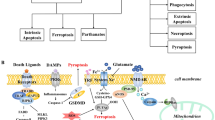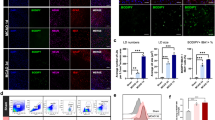Abstract
Nicotine has been reported to exert certain protective effect in the Parkinson’s and Alzheimer’s diseases. Whether it has a similar action in focal cerebral ischemia was unclear. In the present study, rats received either an injection of (−)-nicotine hydrogen tartrate salt (1.2 mg/kg, i.p.) or the vehicle 2 h before the 120 min middle cerebral artery occlusion. Neurological deficits and histological injury were assessed at 24 h after reperfusion. The content of endocannabinoids and the expression of cannabinoid receptor CB1 in brain tissues were determined at different time points after nicotine administration. Results showed that nicotine administration ameliorated neurological deficits and reduced infarct volume induced by cerebral ischemia in the rats. The neuroprotective effect was partially reversed by CB1 blockage. The content of the endocannabinoids N-arachidonylethanolamine and 2-arachidonoylglycerol, as well as the expression of cannabinoid receptor CB1 were up-regulated in brain tissues after nicotine delivery. These results suggest that endogenous cannabinoid system is involved in the nicotine-induced neuroprotection against transient focal cerebral ischemia.



Similar content being viewed by others
References
Borlongan CV, Shytle RD, Ross SD, Shimizu T, Freeman TB, Cahill DW, Sanberg PR (1995) Nicotine protects against systemic kainic acid induced excitotoxic effects. Exp Neurol 136:261–265
Baron JA (1986) Cigarette smoking and Parkinson’s disease. Neurology 36:1490–1496
Morens DM, Grandinetti A, Reed D, White LR, Ross GW (1995) Cigarette smoking and protection from Parkinson’s disease: false association or etiologic clue? Neurology 45:1041–1051
Ciobica A, Padurariu M, Hritcu L (2012) The effects of short-term nicotine administration on behavioral and oxidative stress deficiencies induced in a rat model of Parkinson’s disease. Psychiatr Danub 24:194–205
Viveros MP, Marco EM, Llorente R, Lamota L (2007) The role of the hippocampus in mediating emotional responses to nicotine and cannabinoids: a possible neural substrate for functional interactions. Behav Pharmacol 18:375–389
Gamaleddin I, Wertheim C, Zhu AZ, Coen KM, Vemuri K, Makryannis A, Goldberg SR, Le Foll B (2012) Cannabinoid receptor stimulation increases motivation for nicotine and nicotine seeking. Addict Biol 17:47–61
Merritt LL, Martin BR, Walters C, Lichtman AH, Damaj MI (2008) The endogenous cannabinoid system modulates nicotine reward and dependence. J Pharmacol Exp Ther 326:483–492
Nagayama T, Sinor AD, Simon RP, Chen J, Graham SH, Jin K, Greenberg DA (1999) Cannabinoids and neuroprotection in global and focal cerebral ischemia and in neuronal cultures. J Neurosci 19:2987–2995
Hayakawa K, Irie K, Sano K, Watanabe T, Higuchi S, Enoki M, Nakano T, Harada K, Ishikane S, Ikeda T, Fujioka M, Orito K, Iwasaki K, Mishima K, Fujiwara M (2009) Therapeutic time window of cannabidiol treatment on delayed ischemic damage via high-mobility group box1-inhibiting mechanism. Biol Pharm Bull 32:1538–1544
Wang Q, Peng Y, Chen S, Gou X, Hu B, Du J, Lu Y, Xiong L (2009) Pretreatment with electroacupuncture induces rapid tolerance to focal cerebral ischemia through regulation of endocannabinoid system. Stroke 40:2157–2164
Hata R, Mies G, Wiessner C, Fritze K, Hesselbarth D, Brinker G, Hossmann KA (1998) A reproducible model of middle cerebral artery occlusion in mice: hemodynamic, biochemical, and magnetic resonance imaging. J Cereb Blood Flow Metab 18:367–375
Garcia JH, Wagner S, Liu KF, Hu XJ (1995) Neurological deficit and extent of neuronal necrosis attributable to middle cerebral artery occlusion in rats: statistical validation. Stroke 26:627–634
Bederson JB, Pitts LH, Germano SM, Nishimura MC, Davis RL, Bartkowski HM (1986) Evaluation of 2,3,5-triphenyltetrazolium chloride as a stain for detection and quantification of experimental cerebral infarction in rats. Stroke 17:1304–1308
Patel S, Rademacher DJ, Hillard CJ (2003) Differential regulation of the endocannabinoids anandamide and 2-arachidonylglycerol within the limbic forebrain by dopamine receptor activity. J Pharmacol Exp Ther 306:880–888
Nanri M, Kasahara N, Yamamoto J, Miyake H, Watanabe H (1997) GTS-21, a nicotinic agonist, protects against neocortical neuronal cell loss induced by the nucleus basalis magnocellularis lesion in rats. Jpn J Pharmacol 74:285–289
Decker MW, Majchrzak MJ, Anderson DJ (1992) Effects of nicotine on spatial memory deficits in rats with septal lesions. Brain Res 572(1–2):281–285
Gao ZG, Cui WY, Zhang HT, Liu CG (1998) Effects of nicotine on 1-methyl-4-phenyl-1,2,5,6-tetrahydropyridine-induced depression of striatal dopamine content and spontaneous locomotor activity in C57 black mice. Pharmacol Res 38(2):101–106
Stevens Tanya R, Krueger Stefan R, Fitzsimonds Reiko M, Picciotto Marina R (2003) Neuroprotection by nicotine in mouse primary cortical cultures involves activation of calcineurin and L-type calcium channel inactivation. J Neurosci 3:10093–10099
Belluardo N, Mudo G, Blum M, Fuxe K (2000) Central nicotinic receptors, neurotrophic factors and neuroprotection. Behav Brain Res 113:21–34
Akaike A, Takada-Takatori Y, Kume T, Izumi Y (2010) Mechanisms of neuroprotective effects of nicotine and acetylcholinesterase inhibitors: role of alpha4 and alpha7 receptors in neuroprotection. J Mol Neurosci 40(1–2):211–216
Quik M, Perez XA, Bordia T (2012) Nicotine as a potential neuroprotective agent for Parkinson’s disease. Mov Disord 27(8):947–957
Takarada T, Nakamichi N, Kawagoe H, Ogura M, Fukumori R, Nakazato R, Fujikawa K, Kou M, Yoneda Y (2012) Possible neuroprotective property of nicotinic acetylcholine receptors in association with predominant upregulation of glial cell line-derived neurotrophic factor in astrocytes. J Neurosci Res 90(11):2074–2085
Panikashvili D, Shein NA, Mechoulam R, Trembovler V, Kohen R, Alexandrovich A, Shohami E (2006) The endocannabinoid 2-AG protects the blood– brain barrier after closed head injury and inhibits mRNA expression of proinflammatory cytokines. Neurobiol Dis 22:257–264
Ma L, Zhu Z, Zhao Y, Hou L, Wang Q, Xiong L, Zhu X, Jia J, Chen S (2011) Cannabinoid receptor type 2 activation yields delayed tolerance to focal cerebral ischemia. Curr Neurovasc Res 8:145–152
Amantea D, Spagnuolo P, Bari M, Fezza F, Mazzei C, Tassorelli C, Morrone LA, Corasaniti MT, Maccarrone M, Bagetta G (2007) Modulation of the endocannabinoid system by focal brain ischemia in the rat is involved in neuroprotection afforded by 17beta-estradiol. FEBS J 274:4464–4775
Degn M, Lambertsen KL, Petersen G, Meldgaard M, Artmann A, Clausen BH, Hansen SH, Finsen B, Hansen HS, Lund TM (2007) Changes in brain levels of N-acylethanolamines and 2-arachidonoylglycerol in focal cerebral ischemia in mice. J Neurochem 103:1907–1916
Panikashvili D, Simeonidou C, Ben-Shabat S, Hanus L, Breuer A, Mechoulam R, Shohami E (2001) An endogenous cannabinoid (2-AG) is neuroprotective after brain injury. Nature 413:527–531
Pacher P, Hasko G (2008) Endocannabinoids and cannabinoid receptors in ischaemia-reperfusion injury and preconditioning. Br J Pharmacol 153:252–262
Biala G, Kruk M (2008) Cannabinoid receptor ligands suppress memory-related effects of nicotine in the elevated plus maze test in mice. Behav Brain Res 192:198–202
Acknowledgments
This work was supported in part by the National Natural Science Foundation of China (Grant 81171237 to Hanfei Sang and Grant 30725039 to Lize XIONG).
Author information
Authors and Affiliations
Corresponding authors
Additional information
Yu Chen and Huang Nie are contributed equally to this work.
This work was conducted in the laboratory of Department of Anesthesiology, Xijing Hospital, the Fourth Military Medical University, Xi’an, Shaanxi, China.
Rights and permissions
About this article
Cite this article
Chen, Y., Nie, H., Tian, L. et al. Nicotine-Induced Neuroprotection Against Ischemic Injury Involves Activation of Endocannabinoid System in Rats. Neurochem Res 38, 364–370 (2013). https://doi.org/10.1007/s11064-012-0927-6
Received:
Revised:
Accepted:
Published:
Issue Date:
DOI: https://doi.org/10.1007/s11064-012-0927-6




